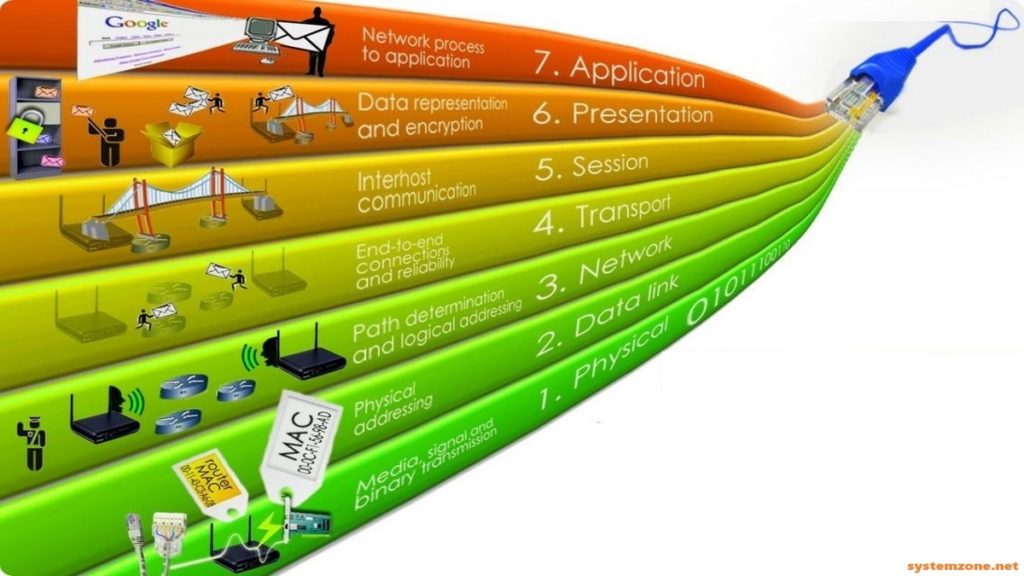What Are the 7 Layers of OSI Model and How Do They Work
The OSI Model stands for Open Systems Interconnection Model, a conceptualized framework used to describe the seven layers of a telecommunication system or network. It was established as an international standard in the year 1984 by the International Organization for Standardization. This model helps visualize how networks operate and is still used today to figure out and solve network problems, such as by a web development company. In this article, we will talk about the 7 layers of the OSI Model and how each of them work.

Layer 1 – Physical Layer
The physical layer concerns the part of the model used for transmitting raw data bits (0s and 1s) across the network between sending and receiving devices. This can be through a physical cable or even a wireless connection between physical nodes. The physical layer can also represent voltages, frequencies, pin layouts, and other things. Any other physical devices part of this transmission, like hubs and modems, are also included.
Ethernet, USB, Bluetooth, IEEE 802.11 etc. protocols work on Physical Layer.
Layer 2 – Data Link Layer
The data link layer is in charge of establishing or eliminating a connection between physical nodes that may be connected through a cable or wirelessly. In addition, it also takes care of any data correction for errors that might be made in the physical layer. The data link layer is made up of two sub layers of its own which are:
– The media access control (MAC) is responsible for the data transmission and the provision of data flow by defining permissions across the network.
– The Logical Link Control (LLC) is responsible for controlling the data flow and identifying errors that occur from flow from physical media. In addition, it also identifies network protocols.
PPP, ATM etc. protocols work on Data Link Layer.
Layer 3 – Network Layer
The network layer’s primary responsibility is receiving packets of data from the data link layer and then moving them ahead. It fulfills this duty by finding the best route of forwarding these packets using the address that has been given to them by the data link layer. In essence, it routes the packets to the destination, and this is where router devices tend to come in handy as the ‘routing’ of information is taking place.
IP, ARP, ICMP, IPsec etc. protocols work on Network Layer.
Layer 4 – Transport Layer
The transport layer is responsible for data transmission between the transmitting and receiving ends. It does this by initially breaking up the data at the transmission end and then constructing it back at the receiving end. The transport layer also deals with error control and checks if there is any incorrect data sending. If an error has occurred during transmission, it is responsible for requesting it again from the transmission end.
An excellent example of the transport layer is the Transmission Control Protocol (TCP). UDP is also works on Transport Layer.
Layer 5 – Session Layer
The session layer is responsible for creating sessions between computers, i.e., communication channels to transfer data between them. In addition, it is responsible for keeping these channels open during data transmission and ending them when this transfer has been completed. It can also create checkpoints in data transfer to resume the transfer from the last checkpoint in case the session has been interrupted.
Example of Session Layer protocols are NetBIOS, PPTP etc.
Layer 6 – Presentation Layer
The presentation layer is responsible for the encryption of data between two devices. It informs the devices how it has coded and compressed the data to be decrypted at the receiving end. In this way, it is essentially responsible for preparing the data for the application layer and transmits any data from it back to the session layer if needed.
SSL and TLS are the best example of Presentation Layer.
Layer 7 – Application Layer
The Application is the layer at the top of the OSI Model and is what users mostly see when they are using end-user software, like their web browser or Microsoft Office. It provides protocols to the software to allow it to send and receive information directly from users and display it to them. Some of these protocols include HTTP, FTP, and DNS. It is important to note that the applications themselves are not present in this layer, but instead, it allows them to communicate to the lower layers for communication with applications on the other side.
In conclusion
The OSI Model is an internationally approved framework that allows us to understand how network systems work, which can help picture how they work. It consists of 7 layers which each have its role and way of working that make up a whole of communication systems. We hope this has been informative and that you can use this to boost your knowledge further about networks and how they work.
Why not a Cup of COFFEE if the solution?

